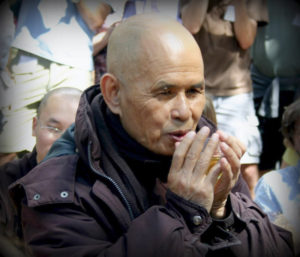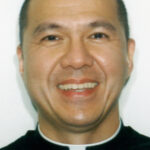Zen Master known for bridging Eastern and Western spirituality
By Katie Kiley
For The Catholic Messenger
Zen Master Thich Nhat Hanh, renowned for bridging Eastern and Western spirituality, is the 2015 Pacem in Terris Peace and Freedom Award recipient.

Thich Nhat Hanh has been named the Pacem in Terris Peace and Freedom Award winner.
Traditionally, the honoree of this peace prize — based on the 1963 Pacem in Terris encyclical of Pope John XXIII — journeys to Davenport to receive the award. However, because the 89-year old “Thay” (or Teacher) is recovering from a severe stroke, Bishop Martin Amos will travel to Deer Park Buddhist Monastery in southern California to present the award. A designee of Thay (pronounced “tie”) and his visiting community of 120 Vietnamese monastics will accept the award on their leader’s behalf.
He is receiving the Pacem in Terris award Oct. 31, on the 50th anniversary year of Martin Luther King Jr.’s selection for the same award. The two religious leaders shared a peace and nonviolence bond that influenced the political climate in the late 1960s. Deeply troubled by the war in his country, and recognizing a fellow peace advocate, Thay wrote to King in 1965 asking him to publicly denounce the Vietnam War. The American Civil Rights leader honored Thay’s plea by speaking against the war in his famous 1967 speech at the Riverside Church in New York City. Earlier that year, King nominated Thay for the Nobel Peace Prize, referring to him as “an apostle of peace and non-violence.”
Thay is widely recognized as the founder of Socially Engaged Buddhism and father of the Mindfulness movement in Western culture. The Vietnam War forced Thay and the entire Buddhist community of monks and nuns to confront “the question of whether to adhere to the contemplative life, meditating in their monasteries, or to help those suffering around them.”
The First Noble Truth of Buddhism deals with suffering, which Thay translated into a modern Western context by explaining that “in order for practitioners to alleviate suffering, they need to have direct experience of suffering in their own era.”
In 1964 he responded to suffering by organizing a team and seven boats filled with food. At great personal risk, he navigated this flotilla to the desperate Vietnamese stranded in the mountains by war and floods.
He supported the “Call to Peace,” a 1965 statement by Buddhist students addressing the North and South Vietnamese governments. In the same year he wrote to King for help, he also established the School of Youth for Social Service (SYSS), which carried out peace missions to rebuild war-ravaged Vietnamese villages. From this group of dedicated students, Thay established the Order of Inner Being, creating centers where lay and monastics received Mindfulness training.
As his peace efforts escalated, so did the risks, and he was forced to flee Vietnam in 1966 after an assassination attempt. Thay harnessed his exiled status to reconcile Eastern and Western political and spiritual challenges in an effort to realize his lifelong commitment to universal peace and justice.
In 1969, Thay was chosen to represent the Buddhist Peace Delegation for the Paris Peace talks which resulted in the signing of the 1973 Paris Peace Accords but also cemented his exile from Vietnam.
In 1976 Thay attended the World Conference on Religion and Peace in Singapore where he witnessed firsthand the plight of the Vietnamese refugees (Boat People), and organized efforts to rescue them. Some have noted that the plight of the Vietnamese refugees fleeing war in rickety boats, and preyed upon by pirates in the mid 1970s, is disturbingly similar to the plight of present-day Syrian refugees.
Since his exile from Vietnam, his life has been dedicated to the work of Inner Transformation for the benefit of the individual and of the society as a whole. Inner Transformation, in Thay’s view, begins with unlocking the energy of Mindfulness. The anchor of Mindfulness practice is moment-by-moment awareness of the miracle of the in-breath and the out-breath. Mindful breathing, Mindful walking, Mindful eating — these are doors to open the heart and center the mind. Mindfulness practice nurtures self-understanding and forgiveness, and engenders deep listening and compassionate action for the benefit of all including enemies, and the Earth. Mindfulness finds its most genuine expression when practiced as a community.
In 1982, Thay founded Plum Village near Bordeaux, France, which has grown to four interconnected monasteries. He also founded three monasteries in the United States and two in Vietnam. (The two monasteries in Vietnam have recently been suppressed by the Vietnamese government.) The monasteries serve as centers where laity develop the tools for Engaged Buddhism. Here, deep listening makes the teachings on compassionate action accessible and alive.
Back in the U.S., Thay led peace walks in 2005 and 2007 to address racial tension in Los Angeles. Also in 2007, he organized and conducted “Great Chanting Ceremonies” intended to mindfully bind the remaining wounds from the Vietnam War. More recently, he sent delegates to the 2014 Conference on Slavery and Human Trafficking.
Until his illness, Thay continued to travel the world, conferring with political and religious leaders, enlisting their support in pursuit of lasting world peace.
In a 2013 news release from the Plum Village Monastics, Thay reflected: “On the altar in my hermitage in France are images of Buddha and Jesus, and every time I light incense, I touch both of them as my spiritual ancestors.”
Thich Nhat Hanh, this year’s Pacem in Terris Peace and Freedom Award winner, is a scholar fluent in seven languages and the author of more than 100 books: “Being Peace;” “Peace in Every Step;” “Lotus in a Sea of Fire;” “Living Buddha, Living Christ;” “Touching Peace;” “Peace Begins Here,” and a poem on the plight of the Vietnamese Boat People, “Call Me By My True Name.” He also is prolific calligrapher, teacher, and global voice for peace.












Congratulation Thầy and your Sanghas! We are so glad to know this news. Best wishes for your recovery. CH
Thank you so much for this wonderful article about our Teacher. I might note that in 1970, Thay also helped organize the largest environmental conference ever held, with 2200 scientists. Their joint declaration is known as the Menton Statement. The Order that Thay founded is the Order of Interbeing, which recognizes our inter-being with one another, with all sentient beings and Mother Earth herself. _()_
Dear Thay, thank you for teaching all of us. Love to you.
Dear Thay, Dear Sangha, we are so blessed by Thay’s message of peace and understanding and I am very grateful for the award for Thay and George’s comment about the Menton Statement. Thay has worked so diligently to bring peace to our world. Boundless gratitude! _()_
Welcome! Monks tell son monks
thank you for writing this article. please note that ‘Order of Inner Being’ is ‘Order of Inter-Being’.
may peace prevail in all our hearts and this world.
Thank you so much for this wonderful article!
Thay has indeed laid the groundwork for and nurtured the development of “The Beloved Community” – an aspiration he shared with Martin Luther King, Jr.
Congratulations Thay and all Plumvillage Monasteries around the world! The very first book I read from Thay is Lotus in a Sea of Fire, written by Thay in 1966, around one year after being in exile from the then Vietnamese Government of the South. After reading the whole book for just one night, I realised that the author was a great man! But I had no chance to meet him until in 1986 when he came to Australia for dharma teaching in Latrobe University in Melbourne. I recommend people to read that book. My bilingual website Engagingbuddhism.wordpress.com
Dear Thay Dear Sangha,
I am so grateful for finding Thay and his practice of Engaged Buddism!!I have been living at his Monastery in New York state for eight years and have received thru his monastics the gifts that he has shared with the world .His deep commitment for peace in his country and in the rest of the world which resolted in being exiled from Vietnam.He has been unstoppable however in continuing his work for freedom,protecting our environment,helping individuals to deal with their own personal suffering .Thay has made endless contributions for personal and Global well being.I am so honored to have him and teachings in my life He is not about just beautiful Dharma talks but about action!!!Congratulations Dear Thay!!!
Well deserved good and faithful servant
Congratulations, my beloved teacher Thay!
And it is the Order of Interbeing, not Inner being, to emphasize our interconnectness. Nothing and no one can exist without everything else: we are interdependent on each other for life: we need the sun, the earth, the rain, the carrots, each other to exist, just as the flower needs sun, water, shade to grow and flourish.
Dear Thay, you’re amazing monk.
It’s a wonderful news. One of the great Buddhist messengers of peace was recognized by the Catholic Church. A loud and clear message of brotherhood/ sisterhood, understanding and compassion has been sent to all sentient beings. So proud to be Thay’s disciple.
Dear Thay,
you are my beloved teacher and I’m very happy for this peace prize.
Thank you for your teachings, every day you are in my thoughts.
With gratitude.